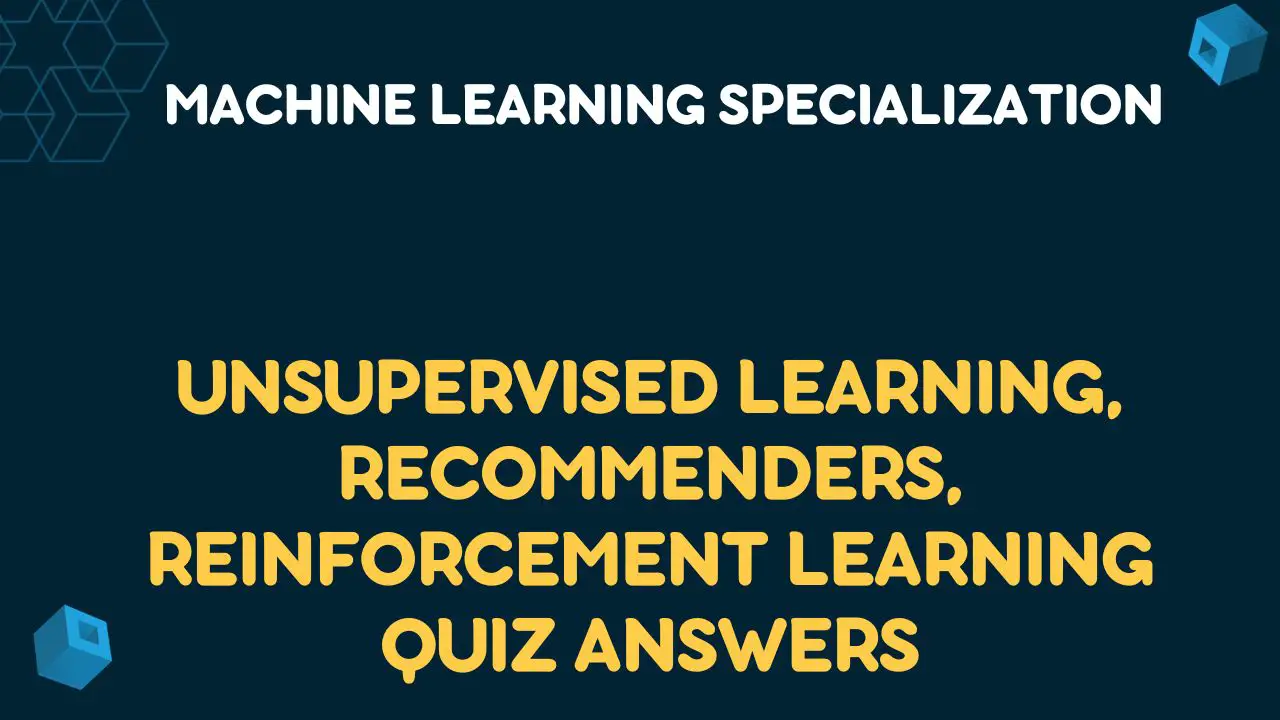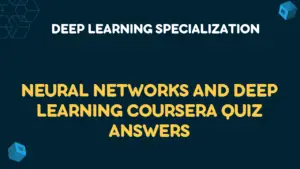Get All Weeks Unsupervised Learning, Recommenders, Reinforcement Learning Quiz Answers
Table of Contents
Week 01: Unsupervised Learning, Recommenders, Reinforcement Learning Quiz Answers
Clustering Quiz Answers
Q1. Which of these best describes unsupervised learning?
Q2. Which of these statements are true about K-means? Check all that apply.
View2.The number of cluster assignment variables c^{(i)}c(i) is equal to the number of training examples.
Q3. You run K-means 100 times with different initializations. How should you pick from the 100 resulting solutions?
View.
Q4. You run K-means and compute the value of the cost function J(c^{(1)}, …, c^{(m)}, \mu_1, …, \mu_K)J(c(1),…,c(m),μ1,…,μK) after each iteration. Which of these statements should be true?
ViewQ5. In K-means, the elbow method is a method to
ViewAnomaly Detection Quiz Answers
Q1. You are building a system to detect if computers in a data center are malfunctioning. You have 10,000 data points of computers functioning well, and no data from computers malfunctioning. What type of algorithm should you use?
ViewQ2. You are building a system to detect if computers in a data center are malfunctioning. You have 10,000 data points of computers functioning well and 10,000 data points of computers malfunctioning. What type of algorithm should you use?
ViewQ3. Say you have 5,000 examples of normal airplane engines and 15 examples of anomalous engines. How would you use the 15 examples of anomalous engines to evaluate your anomaly detection algorithm?
ViewQ4. Anomaly detection flags a new input xx as an anomaly if p(x) < \epsilonp(x)<ϵ. If we reduce the value of \epsilonϵ, what happens?
ViewQ5. You are monitoring the temperature and vibration intensity on newly manufactured aircraft engines. You have measured 100 engines and fit the Gaussian model described in the video lectures to the data. The 100 examples and the resulting distributions are shown in the figure below.
View2.17.5 * 48 = 840
Week 02: Unsupervised Learning, Recommenders, Reinforcement Learning Quiz Answers
Collaborative Filtering Quiz Answers
Q1. You have the following table of movie ratings:
| Movie | Elissa | Zach | Barry | Terry |
| Football Forever | 5 | 4 | 3 | ? |
| Pies, Pies, Pies | 1 | ? | 5 | 4 |
| Linear Algebra Live | 4 | 5 | ? | 1 |
Refer to the table above for questions 1 and 2. Assume numbering starts at 1 for this quiz, so the rating for Football Forever by Elissa is at (1,1)
What is the value of n_unu
ViewQ2. What is the value of r(2,2)r(2,2)
ViewQ3. In which of the following situations will a collaborative filtering system be the most appropriate learning algorithm (compared to linear or logistic regression)?
View.
Q4. For recommender systems with binary labels y, which of these are reasonable ways for defining when yy should be 1 for a given user jj and item ii? (Check all that apply.)
View2.yy is 1 if user jj fav/likes/clicks on item ii (after being shown the item)
Recommender systems implementation Quiz Answers
Q1. The lecture described using ‘mean normalization’ to do feature scaling of the ratings. What equation below best describes this algorithm?
ViewQ2. The implementation of collaborative filtering utilized a custom training loop in TensorFlow. Is it true that TensorFlow always requires a custom training loop?
ViewQ3. Once a model is trained, the ‘distance’ between feature vectors gives an indication of how similar items are.
The squared distance between the two vectors \mathbf{x}^{(k)}x(k) and \mathbf{x}^{(i)}x(i) is:
Using the table below, find the closest item to the movie “Pies, Pies, Pies”.
| Movie | User 1 | … | User n | x_0x0 | x_1x1 | x_2x2 |
| Pastries for Supper | 2.0 | 2.0 | 1.0 | |||
| Pies, Pies, Pies | 2.0 | 3.0 | 4.0 | |||
| Pies and You | 5.0 | 3.0 | 4.0 |
1.Pies and You
2.Pastries for Supper
Q4. Which of these is an example of the cold start problem? (Check all that apply.)
View2.A recommendation system is unable to give accurate rating predictions for a new product that no users have rated.
Content-based filtering Quiz Answers
Q1. Vector x_uxu and vector x_mxm must be of the same dimension, where x_uxu is the input features vector for a user (age, gender, etc.) x_mxm is the input features vector for a movie (year, genre, etc.) True or false?
ViewQ2. If we find that two movies, ii and kk, have vectors v_m^{(i)}vm(i) and v_m^{(k)}vm(k) that are similar to each other (i.e., ||v_m^{(i)} – v_m^{(k)}||∣∣vm(i)−vm(k)∣∣ is small), then which of the following is likely to be true? Pick the best answer.
ViewQ3. Which of the following neural network configurations are valid for a content-based filtering application? Please note carefully the dimensions of the neural network indicated in the diagram. Check all the options that apply:
ViewQ4. You have built a recommendation system to retrieve musical pieces from a large database of music and have an algorithm that uses separate retrieval and ranking steps. If you modify the algorithm to add more musical pieces to the retrieved list (i.e., the retrieval step returns more items), which of these are likely to happen? Check all that apply.
ViewQ5. To speed up the response time of your recommendation system, you can pre-compute the vectors v_m for all the items you might recommend. This can be done even before a user logs in to your website and even before you know the x_uxu or v_uvu vector. True/False?
ViewWeek 03: Unsupervised Learning, Recommenders, Reinforcement Learning Quiz Answers
Reinforcement Learning Introduction Quiz Answers
Q1. You are using reinforcement learning to control a four-legged robot. The position of the robot would be its _____.
ViewQ2. You are controlling a Mars rover. You will be very very happy if it gets to state 1 (significant scientific discovery), slightly happy if it gets to state 2 (small scientific discovery), and unhappy if it gets to state 3 (rover is permanently damaged). To reflect this, choose a reward function so that:
ViewQ3. You are using reinforcement learning to fly a helicopter. Using a discount factor of 0.75, your helicopter starts in some state and receives rewards -100 on the first step, -100 on the second step, and 1000 on the third and final step (where it has reached a terminal state). What is the return?
ViewQ4. Given the rewards and actions below, compute the return from state 3 with a discount factor of \gamma = 0.25γ=0.25.

State-action value function Quiz Answers
Q1. Which of the following accurately describes the state-action value function Q(s,a)Q(s,a)?
ViewQ2. You are controlling a robot that has 3 actions: ← (left), → (right) and STOP. From a given state ss, you have computed Q(s, ←) = -10, Q(s, →) = -20, Q(s, STOP) = 0.
What is the optimal action to take in state ss?
ViewQ3. For this problem, \gamma = 0.25γ=0.25. The diagram below shows the return and the optimal action from each state. Please compute Q(5, ←).

Continuous state spaces Quiz Answers
Q1. The Lunar Lander is a continuous state Markov Decision Process (MDP) because:
ViewQ2. In the learning algorithm described in the videos, we repeatedly create an artificial training set to which we apply supervised learning where the input x = (s,a)x=(s,a) and the target, constructed using Bellman’s equations, is y = _____?
ViewQ3. You have reached the final practice quiz of this class! What does that mean? (Please check all the answers, because all of them are correct!)
View2.The DeepLearning.AI and Stanford Online teams would like to give you a round of applause!
3.You deserve to celebrate!
4.What an accomplishment — you made it!
Conclusion:
In conclusion, our journey through the realms of Unsupervised Learning, Recommenders, and Reinforcement Learning has been a remarkable voyage into the fascinating world of machine learning. We’ve explored diverse and powerful techniques that enable machines to uncover patterns, make recommendations, and learn through interaction.
Get All Course Quiz Answers of Machine Learning Specialization
Supervised Machine Learning: Regression and Classification Quiz Answers
Advanced Learning Algorithms Coursera Quiz Answers
Unsupervised Learning, Recommenders, Reinforcement Learning Quiz Answers



